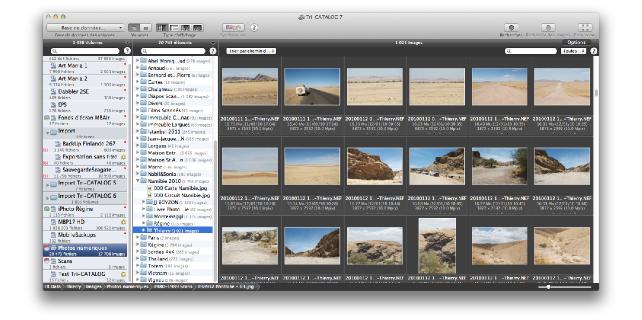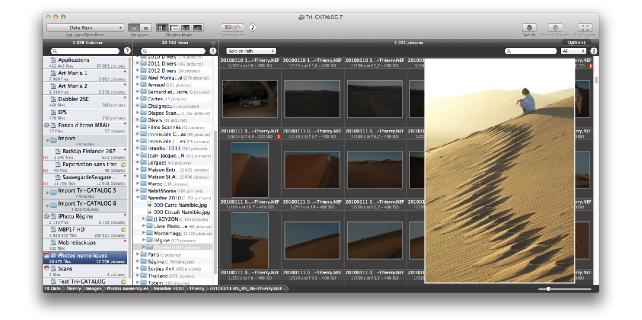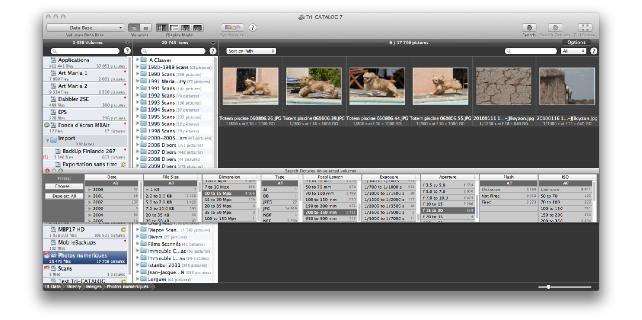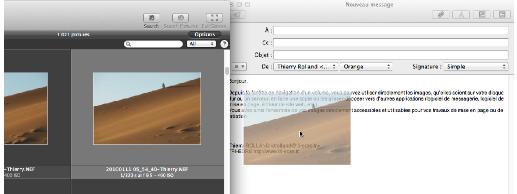 | |||||||||||||
 | ||||||||||
Catalog and share | ||||||||||
(Mac OS X 10.4 and 10.5 : Use Tri-CATALOG 6) | ||||||||||
| |||||||||||
The creation of "virtual volumes" Tri-CATALOG can analyze the content of any volume (disk, partition, CD, DVD, USB key, etc.) or folder. It creates a "virtual volume" containing the list of files and folders in the hierarchical organization, and the views of all the images (as thumbnails). So you can keep all the content you want in your database while using only a limited space. Note: Options are provided to limit the images for which a thumbnail is created and set the thumbnail size. Browse the "virtual volumes" All "virtual volumes" that you have created are available at any time, even if the original disk is no longer available. You can browse their contents, view images and read the information (file attributes, EXIF and IPTC data of images, etc.). The main window displays a list of all volumes analyzed (left), the contents of the selected volume and images.
An image can be displayed in large in the browser (with the maximum size of the thumbnail stored in the "virtual volume") or even full screen if the original image is available.
Search the "virtual volumes" If you need to find an image or file, search in the data base on some or all of the volumes saved. Research can be done on the images of a particular volume, using the name as well as file attributes (date, size, etc.) and shooting attributes (exposure, aperture, focal length, sensitivity, etc..) by selecting the desired values in the panel of research. Only images that match the selected criteria are displayed:
A multi-criteria search is also possible on the entire data base or selected volumes. Share the "virtual volumes" For each volume, there is a file "virtual volume" created in the database. The analysis of a disk (or folder) You can share volumes with other users or other machines, so they can see your pictures and photos (as thumbnails) and the list of files contained in the original volume (but they will not access the real pictures and files). This is an easy way to share or send your images to others. You can yourself see the "virtual volumes" created by other users, but you can not share these volumes or edit them. Share volumes by sending "virtual volumes": You can send a "virtual volume" by e-mail, or by copying across a network, a USB key, etc.. The recipient will just need to have a version of Tri-CATALOG 7 (including the free version "Free Reader"), and copy the "virtual volume" in its local database to view the images and content of the volume you send. Share volumes with the sharing features: Tri-CATALOG offers several ways to share volumes of the database, in addition to that described in the preceding paragraph. You can use DropBox, iCloud, a FTP server or a remote server over a LAN to share volumes. Tri-CATALOG use as image server From the browser window showing a volume, you can directly use the images, whether they are on your hard drive or server, make a copy or drag and drop to other applications (mail software, website editor, etc..). For example, you can easily add an image in an email (without needing the original):
Use Tri-CATALOG in READER mde Tri-CATALOG can be used in consultation only (Reader). All volumes are available from the data base with the display and research functions, but the user can not modify the data base. A "READER Free" mode allows you to use Tri-CATALOG free (without needing a license) to view a single volume (created by a registered version of Tri-CATALOG). This makes it easy to send a "virtual volume" to another person who can easily visualize your images. Import old database Tri-CATALOG (4, 5 or 6) Tri-CATALOG 7 can convert and import volumes analyzed with older versions (since version 4). You can then use directly all the work already done with an older version. Main Features
Minimal Configuration Macintosh with Intel processor | ||



 by Tri-CATALOG creates a "virtual volume" in the database:
by Tri-CATALOG creates a "virtual volume" in the database: 
